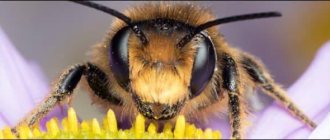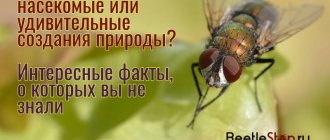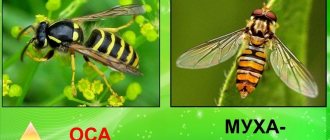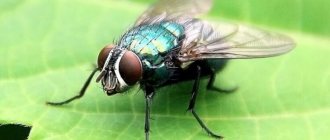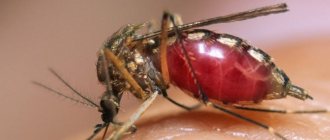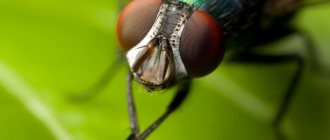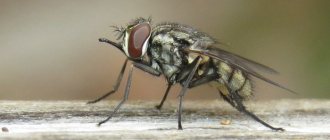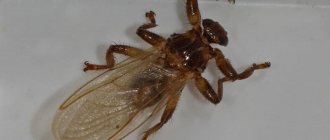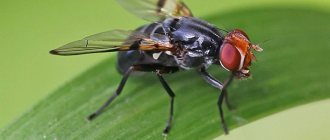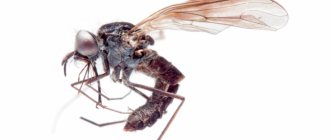When a person sees a fly in his house, the first thing he tries to do is kill it. The insect is an irritant for household members and it has to activate all its unique abilities in order to anticipate the approaching danger. And she succeeds. People are involuntarily puzzled by how many eyes a fly has, that it is always able to escape in time.
Number of eyes in a fly
Focusing on our own perception of the world around us, most of us, when answering the question: how many eyes does an ordinary fly have, will say without hesitation: two. But in fact, these dipterous insects have more visual organs than people, animals and birds.
When examining an insect with the naked eye, a person can only see 2 large oval eyes on the sides of the fly's head. Meanwhile, she has 3 more small, barely noticeable organs of vision located in the frontal part.
The large eyes are called the main eyes; they have a complex structure that provides the insect with a panoramic vision of the world. Small eyes are auxiliary, and with them the fly not only sees, but rather “focuses” for a better look at the fragments.
The sex of the insect can be determined by the distance between the main eyes. In females they are more spaced apart than in males. Because of this, in males the frontal part is almost invisible.
Room dweller
The housefly or housefly belongs to the family of true flies.
And even though the topic of our review concerns all species without exception, for convenience we will allow ourselves to consider the entire family using the example of this very familiar species of domestic parasites. The common house fly is a very unremarkable insect in appearance. It has a grey-black body coloration, with some hints of yellow on the lower abdomen. The length of an adult individual rarely exceeds 1 cm. The insect has two pairs of wings and compound eyes.
Features of the structure of the eye
The main visual organs of insects consist of many honeycomb-shaped facet cells called ommatidia. The number of these hexagons in the eye of a fly is 4,000. The cells have the shape of a cone, with the narrow end extending into the visual organ.
To understand the structure of the fly eye, it is enough to consider the structure of one ommatidium, which is a complex of 3 functional apparatuses:
- Diopter contains:
- a convex clear lens called the lens (cornea);
- corneal cells that produce a special substance for the cornea;
- a crystalline cone that acts as a collecting lens.
Structural features
- The receptor consists of:
- a bundle of retinal cells located under the cone;
- optic rod passing through the center of the retinal fascicle;
- optic nerves - information carriers.
- The pigment isolation apparatus is presented:
- the main cells that produce pigment;
- side cells;
- retinal.
The first complex in the ommatidium structure refracts and directs light. The receptor site takes in visual information and transmits it to the “processing center.” The third complex gives the fly's eyes a certain color, which can be uneven or uniform. The same apparatus isolates each ommatidia from each other.
How to protect yourself from gadfly larvae?
To avoid infection with gadfly larvae, you must follow simple rules:
- When traveling to southern countries where insects dangerous to humans live, you must take special insecticidal agents that repel flies (sprays, ointments, creams).
- Protective clothing and mosquito nets will help avoid contact with flies.
- Avoid contact with insects in nature and in other places where gadflies gather, for example, on a farm or in a village.
The larva of a gadfly can cause quite a few health problems if you do not consult a doctor promptly.
It is important to know that at the first symptoms, an examination and consultation with a doctor is necessary. Independent actions in this case are unacceptable. Human skin gadfly (Dermatobia hominis)
Human skin gadfly (Dermatobia hominis)
Gadfly happens:
Horse Gadfly
(Gasterophilus intestinalis) belongs to the most common species; its length is 13-16 mm. The color is yellow-brown, the chest is covered with protruding yellow or brownish hairs, the hairs on the abdomen are straw-yellow with an admixture of black. The wings are covered with small dark spots, and on the radial R1 vein, where the remaining R veins branch off, there is a bright black dot. Females have a long ovipositor that bends under the abdomen, and males have trochanters of the hind legs with a process.
Gadfly-hook (larva)
Gasterophilus intestinalis (larva)
(photo from www.diptera.info)
Ready to pupate, they come out along with the droppings and complete their metamorphosis on the ground. Sometimes the first stage larvae penetrate under the skin of a person and, moving in it, cause a “creeping disease” (poricozha). But they cannot fully develop on humans and soon die. Their growth rate depends on the ambient temperature and the condition of the animal itself. Worldwide distribution. Found anywhere there are horses or donkeys.
Life cycle
Gadflies lay eggs in the host's body or sometimes spread them in another way, for example, with an ordinary housefly.
The eggs are laid directly into the animal's skin, where the larvae hatch from the eggs: the animal's high body temperature causes the eggs to mature after contact with the body. Some species of botflies also live in the digestive tract, as skin irritation caused by the larva causes the animal to lick the area, whereby the larva enters the mouth and is swallowed.
Myiases can be caused by the penetration of a larva into the skin (or folds of skin) on a host animal.
Mature larvae fall out of the host and complete the stage of transformation into a pupa already on the ground.
Gadflies are a constant source of difficulty in equestrian sports for people caring for horses, as botflies lay eggs on the inside of horses' legs, on the tibia, on the knees, and sometimes on the throat or nose, depending on the type of botfly. These eggs, like small, yellow blobs, should be removed promptly during the insect breeding season (late summer and early fall) to avoid infecting the horse. When a horse rubs its nose against its legs, the eggs fall into the mouth, and from there into the intestines, where the larva grows and moves into the skin. When the larvae are ripe, the horse develops a tumor the size of a thumbnail; the tumor is not painful, but if it appears in the place where the saddle or bridle is put on, the horse will be unable to work until the wound caused by the appearance of young gadflies heals. In addition, the larva moving to the surface of the skin can cause sores in the mouth, abdominal ulcers and blockage of the intestinal (anal) opening, leading to colic.
Removing eggs
(which cling to the owner's hair) is complicated by the fact that the bone and tendons are located directly under the skin on the tibia: the eggs must be removed with a sharp knife (or blade) or rough sandpaper.
In addition, eggs must be detected in a timely manner before they are ripe. During their maturation, there is a possibility of human infection. Prevention
against larvae can be carried out by spraying with several types of preparations, including dichlorvos, ivermectin and chlorophos.
Scientific classification Kingdom
: Animals
Type
: Arthropods
Class
: Insects
Order
: Diptera
Suborder
: Short-whiskered
Infraorder
: Muscomorpha
Superfamily
: Gadflies
Family
: Gadfly (Gasterophilidae)
Many Russians have encountered these large flies that live in damp rural areas, but few people know that horseflies and gadflies can be deadly to humans.
Features of visual perception
Thanks to such a complex structure of the eyes, the fly perceives the world around it differently than humans. If bipolar vision allows a person to see the whole picture at once, in insects perception occurs differently.
The principle of the facet structure is that each ommatidia is an independent “video camera”, the angle of which includes a small viewing area. The information read by the lens is transmitted by nerve cells to the insect’s brain, where individual puzzles are put together into an overall picture.
To understand how a fly sees, it is enough to recall a child’s mosaic, consisting of individual hexagonal fragments.
The convex design of the eye allows the insect to carry out a panoramic view of space at 3600 (1800 for each eye). In this case, the fly does not perceive large objects that are at rest. Her vision only reacts to movement.
Three auxiliary eyes allow the fly to view objects in close proximity. They also react to changes in light brightness.
Even in the color palette, the world through the eyes of a fly does not look the way a person perceives it. For insects, all colors are richer and brighter. This is due to the peculiarities of refraction of rays passing through the lenses of the eyes. Flies are even able to see different shades of ultraviolet light, which is inaccessible to humans.
Difficult to slam
View of the world
We have already said that flies are color blind, and they either do not distinguish all colors, or they see objects familiar to us in other color tones. This species is also able to distinguish ultraviolet light.
It should also be said that, despite the uniqueness of their vision, these pests practically cannot see in the dark. At night, the fly sleeps because its eyes do not allow this insect to hunt in the dark.
And these pests also tend to perceive well only smaller and moving objects. An insect cannot distinguish objects as large as a person, for example. For a fly, it is nothing more than another part of the interior of the environment.
But the approach of a hand to an insect is perfectly detected by its eyes and promptly gives the necessary signal to the brain. Just like seeing any other rapidly approaching danger, it will not be difficult for these sneakers, thanks to the complex and reliable tracking system that nature has provided them with.
OUR READERS RECOMMEND!
To get rid of insects, our readers recommend the Pest-Reject repeller
. The operation of the device is based on the technology of electromagnetic pulses and ultrasonic waves! Absolutely safe, environmentally friendly product for humans and pets. Read more here...
Flicker frequency
speed of processing information read by the visual apparatus of a fly occurs much faster than the human brain can cope with it. Thanks to facet vision, insects are able to follow rapidly moving objects.
To understand how many frames per second a fly sees, you can compare the following information:
- a person watching a film will perceive a fused image if the film moves at 16 frames per second (the generally accepted standard is 24 frames per second);
- the fly's brain will form a clear picture at a flickering frequency of about 250-300 frames per second.
Hence the instantaneous reaction of an insect to a wave of a person’s hand.
Insects under a microscope
Microscope technology allows you to obtain a picture of any substance or creature, magnified so much that the human eye can perceive it. They began to examine various matters with the help of this device a long time ago, but recently it has become popular to study what is in close proximity to us and can be in contact.
Both butterflies and parasites managed to come under the gun of the powerful device. Upon closer inspection, they all turned out to be not just ugly, but a real flying or jumping nightmare.
A fly under a microscope looks, to put it mildly, strange. A little different from how we are used to seeing her, although the similarity is visible thanks to a pair of large compound eyes, divided into microscopic segments.
We suggest you read: Anti-flea shampoo for cats
Modern scientific developments
Recently, compound eyes have been a subject of study and delight for scientists. After all, such organs of vision, due to their original structure, provide the basis for scientific inventions and research in the world of modern optics. The main advantages are a wide overview of the space, the development of artificial facets, used mainly in miniature, compact, secret surveillance systems.
It might be useful to read:
- Causes and treatment of uterine subinvolution after childbirth;
- Online test “What kind of cat are you? Test how much of a cat you are;
- We take an Igm immunoglobulin test; what kind of test is it?
- “For health you need cold and movement”;
- Peony officinalis Peony flowers in folk medicine;
- Headache and pressure on eyes - what to do? ;
- Healing properties, uses and contraindications of peony petals Peony flowers medicinal properties;
- Blood after constipation Frequent constipation; bloody stool;
Scientific discoveries and technical discoveries
While studying the body structure of flies, scientists became interested in some of their interesting features, which they were able to use in the design of technical devices:
- The unique structure of the fly's eyes, consisting of thousands of 6-sided miniature lenses, in which the image is obtained by summing it in several projections, contributed to the creation of a new camera that can immediately take 1300 pictures of an object (its lens consists of 1327 minilenses), this invention is used in modern computers that perform high-precision calculations;
- the structure of fly eyes is also used to create lattice solar panels that can generate large amounts of electricity;
- aviation engineers, based on the structure of fly wings and halteres, which allow them to become “masters of aerobatics” among all flying insects and birds, were able to create instruments for controlling flights in aircraft, as well as measuring the speed of rockets and airliners;
- By studying the hearing capabilities of flies and the structure of their eardrums, biologists came to the conclusion that the insect is able to determine the source of sound with high accuracy - this will help in improving and developing new designs for hearing aids and microphones;
- research by geneticists of one of the species of vinegar flies helped decipher its gene code and establish a greater degree of identity with the human one, which is planned to be used in the creation of drugs for kidney diseases and leukemia;
- Scientists' plans for the future are to use the physiological characteristics of flies to detect drugs and explosives.
Thus, the participation of mosquitoes and flies in the natural ecosystem brings more benefit than harm. And those who are afraid of being harmed by them can be advised to strictly observe the rules of hygiene in residential premises: regularly clean, throw out garbage on time, destroy incoming pests using available modern methods. This will help reduce the likelihood of harm from any flying insects.
